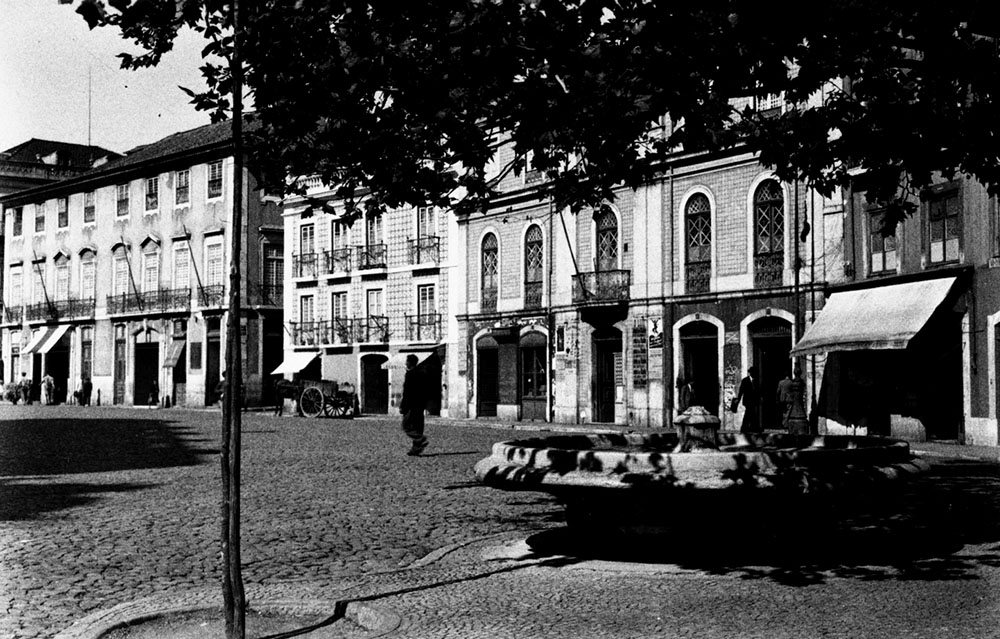INTENDENTE A BRIEF HISTORY
Written by Ivan Carvalho
Lisbon’s charm has long been identified with trams running up sloped streets, the unique patterns found in its calçada portuguesa stone paving and pretty esplanades with spectacular views of the city and River Tejo. Yet in recent years attention has turned to a low-lying swathe of downtown sandwiched between two of the city’s famed seven hills that make up Lisbon’s historic center. An urban renaissance of sorts is underway and its epicenter is an oddly-shaped square that was once little more than a haven for drug dealers and prostitutes.

Largo do Intendente around 1944 Photography by Eduardo Portugal.

Intendente
Lisbon's most diverse neighborhood
Written by Ivan Carvalho
Photography by Stefan Jermann
Lisbon’s charm has long been identified with trams running up sloped streets, the unique patterns found in its calçada portuguesa stone paving and pretty esplanades with spectacular views of the city and River Tejo. Yet in recent years attention has turned to a low-lying swathe of downtown sandwiched between two of the city’s famed seven hills that make up Lisbon’s historic center. An urban renaissance of sorts is underway and its epicenter is an oddly-shaped square that was once little more than a haven for drug dealers and prostitutes.
Largo do Intendente is neither Lisbon’s grandest plaza nor home to famous monuments but it has become a symbol of urban renewal. Both public officials and private citizens have rolled up their sleeves to come up with creative ways to rehabilitate an area that was once deemed off limits due to its status as a red light district. What’s even more interesting is that the efforts of locals have been small-scale – here, you’ll not find any elaborate masterplans drawn up by “starchitects” from abroad. New cafes, shops and cultural associations have little by little begun to transform the area and are attracting young creatives eager for cheap rents as well as a trickle of tourists curious to go beyond the clichéd images of Lisbon usually presented to outsiders (fado, pastel de nata custard tarts, the Castle of São Jorge).
The area known as Intendente is a sort of mini-district that takes in part of the up-and-coming Anjos neighborhood (which last autumn was declared Lisbon’s coolest place to live by the local edition of Time Out magazine) to the north while to the south it includes a section of Mouraria, the city’s former Moorish ghetto that stretches down to the Baixa and which offers a wonderful maze of cobbled streets and old buildings. This urban patch to the northwest of the city’s castle has long been a neighborhood of immigrants (communities of slaves freed in the 18th century, Galicians and recent arrivals from the former colonies and Southeast Asia).
“The area has played a key part in the city’s cultural development,” says Alda Galsterer, a German-born Lisbon resident who operates a contemporary art gallery in the city and who has plans with her husband to open a community arts center in a former carpentry factory not far from Largo do Intendente square. “This melting pot has made important contributions to our local heritage: the West African migrant community and more marginalized sections of Portuguese society helped provide the impetus for the emergence of fado, a soulful music typically associated with Lisbon.”
Everywhere in Intendente one sees immigrant faces from China, Brazil and Africa, a reversal of Portugal’s long forgotten empire when it sent teams of seafaring explorers to colonize vast tracts of territory from Macau to Mozambique for king and country. In place of ethnic enclaves you see a melting pot of food shops and other small businesses run by foreigners from various nationalities, including hidden “clandestino” restaurants operated in upstairs apartments by Chinese who seek to avoid paying taxes. In the works are plans for a mosque and Hindu temple close to each other along Avenida Almirante Reis, the main boulevard that cuts through the area.
The avenue runs past one side of Intendente square, which has been a hub of activity since 2011 when Lisbon’s former mayor António Costa opted to move his office to the rundown area to kickstart urban regeneration. Moving city hall to an area where residents regularly complained of people shooting up heroin in the stairwells of buildings helped to allay locals’ fears about crime. Soon, there was a greater police presence and prostitutes and their male clients became less frequent. Costa also decided to pedestrianize the plaza with the traditional square-cube pavement common to Portuguese cities and he was able to procure an artwork from Joana Vasconcelos, Portugal’s most famous contemporary artist, that now sits in the middle of the square. Her figure-eight love seat done in red wrought iron offers a creative twist on public seating and features a heart-shaped pattern that subtly refers to the streetwalkers who once roamed the area in large numbers. He introduced pro-business schemes for small-scale entrepreneurs that included on-the-spot registration for new start-ups.
Businesses began to appear almost immediately on the square that is marked by historic buildings, some done in the Pombaline style of architecture with more sober tile facades. At no. 19, Marta Silva, a dancer and native of Porto, runs Largo Residências, an arts center that includes a downstairs café and hotel and looks to engage with the local community, helping one-time prostitutes and addicts get off the streets. “This area is a micro climate with its own energy unlike other parts of Lisbon,” she says. “There’s still plenty of grit. It’s not been overrun with tourists.”
Next door to Silva is independent retailer Catarina Portas, whose store occupies the former tile factory of Viúva Lamego, whose decorative hand-painted ceramics are still visible on the building’s exterior. A one-time journalist turned cultural anthropologist and shopkeeper, her store specializes in selling homewares, textiles, soaps and food that are all sourced from Portuguese companies. “What I find interesting about Intendente is that it’s the only neighborhood in Lisbon that’s unexpected. I don’t know what I’ll find in the street and what sort of people I’ll meet. For example, in Avenida da Liberdade or Bairro Alto, you expect to see locals of a certain social class dressed in a certain way and of course there are tourists. Here, it’s surprising. At 5pm, the African immigrants go to the mosque, then you might see Portuguese teenagers loitering about the square. In the evenings, there might be local artists or a foreign couple having a beer at the bar. It’s a meeting spot for people from all facets of society.